#counterphobia
Photo

“I am fascinated by natural forms and their order resulting from geometry, mechanics and physical tension. To logical structure/cosmos, I add feeling/chaos. A permanent sense of loss is a fundamental emotion that drives me.. and beauty is equivalent to a loss- freezing of moments in sculpture is a way to trick time and postpone the inevitable.” The emotive and expressive sculptures created by @goornicki.tomasz touch our hearts and souls. This piece highlights ‘counterphobia’ that leads to actively seeking out anxiety- and fear-inducing situations instead of avoiding them. — #beautifulbizarre #tomaszgornicki #sculpture #artist #sculptor #art #figurativeart #counterphobia #mentalhealth #newcontemporary #contemporaryart #contemporarysculpture https://www.instagram.com/p/CoFM_G3I0ha/?igshid=NGJjMDIxMWI=
#beautifulbizarre#tomaszgornicki#sculpture#artist#sculptor#art#figurativeart#counterphobia#mentalhealth#newcontemporary#contemporaryart#contemporarysculpture
47 notes
·
View notes
Text
Tommy – 6w7
Tommy as a Six
It’s kind of hard to make a six stereotype that actually fits any living six neatly. It’s also really hard to introduce them succinctly. One can say that they’re anxious and safety-driven, but unlike other types that can be flattened into an (often wrong) caricature, it’s generally too obvious from the get-go that it isn’t the whole picture. If you’ve glanced over a six profile with Tommy in mind and gone “He’s like that but also not at all,” welcome to the Six experience.
Child of the algorithm
As soon as I first saw a Youtube analytics page, whatever questions I had about Tommy’s streaming/youtube persona went out the window. YouTube literally quantifies attention in every way you could possibly want, which works incredibly well with someone who has an abundance of two things:
A mind for systems and frameworks
A very strong drive to avoid abandonment
Over time, the internet has been designed to mimic the attention-grabbing impulses of humans, but other humans did it first, and sixes in particular can be good at engaging nearly every form of attention to avoid abandonment. A big drive of the core six is stability (internal and external), preparedness and maintaining a safety net.
Tommy has always talked about relating to YouTube as a video game, finding enjoyment and comfort in being able to look at engagement in solid, reliable measurements. He can make the number go up, he can relate to his performance and behavior with a score, and he can break down other people’s strategies for getting the best results. YouTube is a system that he finds comfort in and literally gets engagement from.
A mind for systems
I have a book lying around with a self-identification questionnaire for each type. There’s a standout line in the Six section: “I might not follow the rules, but I at least want to know what they are.” Sixes naturally gravitate towards thinking in systems, in spite of how chaotic things might look from the outside, or feel from the inside. They tend to feel lost without them and like to orient themselves using them, even if they choose to not follow them or explicitly go against them.
Sixes also tend to have a low-grade fight-or-flight thing going on. This makes for a very interesting combination with their systems-brain, when the systems that they commit to memory become like reflexes. Structures and rules become second nature, and they can flow between following them perfectly and breaking them intuitively. This shows up in Tommy’s use of language (one of the first systems we learn), as well as his remarkable skill in Jazz Piano.
The Seven Wing
Tommy’s Seven wing makes him up-beat and expansive. He’s got a fun-seeking streak, using humor to blow off tension and lighten people’s moods while he’s making friends. He likes to reach out and make connections to a lot of different people so he always has the option of company, even if something else falls through.
While 6w5’s are more withdrawn, 6w7’s have more of a physical and mental wanderlust. Basically, the seven wing lends him part of his chaotic streak.
Counterphobia
Ah, the reason this account exists, explaining counterphobia.
Think of the fight or flight instinct (putting aside freeze and fawn and the other bonus F’s.) When anxiety wakes you up, you have a set of instincts that you can react with reflexively. Regular phobia makes you want to pull away from something, but counterphobia moves you towards it so you can handle it. Most Sixes have a mix of the two, but Sixes who lean primarily on counterphobia more can lead surprisingly dangerous lives for people who are secretly anxious.
Counterphobia can compound onto the Six tendency to anticipate danger. The irony of this happening at an extreme level is they can come off as reckless, seeking out danger and charging right into it for the rush. Tommy does this one a lot, and I wonder if it’s intentional that the people around him have to pay extra attention and take on a disaterbrain way of thinking in order to keep him… alive. When I asked a Six friend about this, they said that it was also very comforting to receive acknowledgement of care, as acting up without anybody reacting can be incredibly shameful.
I’ve seen this line tossed around enough in YouTube comment sections to be comfortable quoting without a source-- “some people are socially awkward, Tommy is awkwardly social.” Tommy turns his social anxiety into forward-moving energy and can get into some fascinatingly bizarre situations because of it. This also makes some of his humor just about as dark as he can get away with, knowing exactly what button he’s not supposed to push and then power-slamming it down.
Sixes are able to burn their anxiety like fuel to propel them forward, sometimes on purpose (deeply valuing bravery) and sometimes on impulse. They can feel the contrast within themselves between what a phobic life and a counterphobic life look like, and in the name of puffing themselves up big to protect themselves and those they love, they choose the latter.
Tommy still has a working sense of self-preservation (sometimes) and is capable of getting nervous about abstract fears as well as practical ones, but more specific situations are more likely to bring about his counterphobic side.
The Loyal Sceptic
One of the things that made Tommy successful as a content creator in the beginning was his impulse to reach out and ask other people how to do things. Sixes like to pool information and opinions to be sure that the choice that they’re making is the best one, and like to have a wide range of references to fall back on. Hell, he asks people for advice as a verbal tick, just inventing questions for people to answer.
Sixes are sceptical. Because systems are so important to the way they get through life, they want to be sure they work first, and can be a natural trouble-shooters if they don’t. Tommy will ask for advice from all kinds of people, but he’s more than capable of arguing against something if it doesn’t seem right. Still, he has faith in people who seem to know what they’re doing—and sometimes a headass decision is good content anyway.
An interesting thing about sixes is they have a complex relationship to being in charge. Someone on the top (in a conventional sense) can’t rely on other people to guide them and are the first to get in trouble if something goes wrong, which is a nightmare scenario for Tommy.
Enter: Wilbur. Wilbur’s willingness (and natural inclination) to act as a mentor to Tommy played a huge part in keeping him stable in his rise to fame, even when Wilbur himself was on the rocks. Having someone to fall back on, ask advice from, and share some blame (in Minecraft) was a big deal for him. Tommy put down an iron-clad attachment to Wilbur, but a detail that gets missed is that although Tommy is very loyal and appreciative of what Wilbur has/can/will do for him, his attachment doesn’t come from pure idealisation.
This clip is a very good example of how Tommy holds onto relationships even when he knows they aren’t ideal. C!Tommy is actually very realistic about C!Wilbur, and you can probably guess what that translates into in real life. Tommy doesn’t burn many bridges and likes to keep his options open when it comes to people. Tommy’s attachment to Wilbur isn’t because he’s perfect, it’s because he’s Wilbur and he’s there, and Tommy can handle troubleshooting and the bumps in the road for as long as he’s got something to hold onto. Dream, Philza and many others also played a mentor role to Tommy during his rise, and he likely has a good sense for who to go to depending on the problem.
Come and go
Sixes also need freedom and space. Most people have to balance their need for connection with their need for personal autonomy, including (and maybe especially?) Sixes. Tommy’s habit of just picking up and leaving when he feels like it? Pretty classic 6w7 behavior. Tommy needs to exert a certain amount of agency over his day to feel alright, so he doesn’t feel merged with the people around him or suffocated.
People who put down roots with Sixes get used to a kind of come-and-go pattern, where their attachment to you is secure enough to last an absence. Tommy is just as likely to get energy from interacting with people as he is when he’s alone, since Sixes are known for being some of the truest ambiverts.
Disintegration to Three
When a Six is under a certain kind of stress, they can act like a version of an unhealthy Three, feeling that they are the only thing in life they can control. Feeling too insecure and suspicious of other peoples input, Sixes can shut down and begin to rely only on themselves, while also having a huge crisis of self-esteem. From here, Sixes take a turn into good old-fashioned overcompensation, becoming concerned with their own image and effectiveness (that word again.)
Most people have versions of who they want to be, but the image-driven influence of the Three contrasting with the fear that they lack the qualities that they want most can make them desperate to prove themselves. The issue with this is that panic makes them put on a funhouse-mirror version of what they think will help them, which tends to be abrasive and maladaptive.
Tommy seems to have toughness, confidence, humor and status as some of his core values that get distorted by Three. He comes off as showy and loud, making a scene of trampling over other people to create a contrast between himself and them. When something doesn’t seem to be working out, he doubles down, thinking that the only way out is through. He generally needs a wrangler to keep this from getting too out of hand, which he is both glad to have (attention) and will fight to the death (agency.)
The interesting thing about this is that Tommy seems to have taken a snapshot of this personality and uses it as part of his streaming persona when he’s In A Mood. It’s reasonable to assume that he may have genuinely slipped in and out of this place in the past, but judging from where he’s at now, this isn’t his full emotional truth anymore. Still, it pops up on stream on occasion, and this might be why people swear up and down that Tommy is a sweetheart off stream but can be a whole other thing when he’s on.
#tmmy 6w7#6 tag#this was a very long way of explaining something that people already intuitively know#Tommy keeps his streming persona because it performs well online and it protects him from being vulnerable on camera#and it both is and isn't him#it's interesting and maybe troubling that he can only get so far away from it as a mask for as long as he has his job#counterphobia
19 notes
·
View notes
Photo


post by subsimulatorGPT2
#drawing anatomically correct hearts is one of the worst tortures you can force upon yourself as an artist#still not as bad as drawing a bed or a car but still#hearts are like escher paintings. i cant make sense of wtf is going on at the top there#but i like this new pen!!! i saw it on drawfee. its the good pen#also notice how ive decided to do dramatic hard shading that clearly shows how bad i am at shading still#digital art#oc art#oc: justice#counterphobia#nudity#gore#blood#body horror
2 notes
·
View notes
Text
Anyways, so. There’s the Insomniac Trio in the Gymrat!AU, right? The twins and Virgil.
Somehow got to rambling about truffle fries one of my local restaurants serves with the co-conspirator. VERY generous portion size for one person. And typically and without fail, they’ve caused carb-overload somnolence like nobody’s business.
And I thought, “What if these three dorks have resorted to just binging on way WAY too many fries as a means of “self-medication”?“
And then thinking Patton would be there going, “Kiddos. Do you WANT to get diabetes?“
Aaand also the fact Remus having PCOS puts him in a high risk group to get diabetes as it is... tho the co-conspirator balked about adding more shit to this man’s health plate as it is.
But like, diabetes sucks but it’s something a lot of people just... live with. Like many other chronic illnesses.
#sanders sides#remus sanders#roman sanders#virgil sanders#patton sanders#food/#(this is just me craving fried food at ungodly hours of the night)#(i would say 'carb coma' but i've grown to acknowledging that that's kind of insensitive)#(oh geez... ro post-ckd dx needs to lay off the salt and i'm just imagining him getting emotional abt that)#(also as a bit of a hypochondriac med nerd... exploring conditions that worry me w/ creative expression... tends to make it less scary?)#(a lot of my love of [body] horror stems from a place of counterphobia and fascination)
2 notes
·
View notes
Link
Chapters: 1/1
Fandom: 僕のヒーローアカデミア | Boku no Hero Academia | My Hero Academia (Anime & Manga)
Rating: Teen And Up Audiences
Warnings: No Archive Warnings Apply
Relationships: Aizawa Shouta | Eraserhead & Bakugou Katsuki
Characters: Aizawa Shouta | Eraserhead, Bakugou Katsuki
Additional Tags: Bakugou Katsuki is a Dork, But also, BAMF Bakugou Katsuki, Aizawa Shouta | Eraserhead Needs a Hug, Crack, aspiring underground hero bakugou question mark, tw inconsistent fic tone lmao, very very very mild manga spoilers
Series: Part 4 of coffee!
Summary:
Shouta stares down at him, feeling distinctly out of his depth.
“This is the worst day of my life,” he says mournfully.
“Thought that was yesterday,” Bakugou hums, apathetic.
“Every day is worse than the last. You’ve exceeded my expectations.”
Bakugou bares his teeth in a shark-like grin.
“Plus ultra, Eraser.”
-
or: aizawa takes bakugou on as an intern. it goes both terribly and phenomenally.
43 notes
·
View notes
Text
Fuck it, cure time
3 notes
·
View notes
Text
“IS SHE BOTHERING YOU QUEEN?” JONES SAYS AS HE IS ABOUT TO BE HURLED ACROSS THE ROOM BY DANNY’S BEST FRIEND, A DEMON
1 note
·
View note
Photo

Counterphobia, n.
the fear and/or dislike of seeking a phobic situation rather than avoiding it. #counterphobia #phobic #situation #fearful #phobia #TPhobias
2 notes
·
View notes
Audio
(Counterphobia)
2 notes
·
View notes
Photo

Today’s Topic: Flirting with Disaster. What can “thrill seeking” teach us about animal training? Do you like scary movies, roller coasters, or maybe sky diving sounds appealing? What is it about these experiences that attracts some people but not others? We will also look into possible equivalent animal models and how this might benefit organisms. And finally, we will explore what we can learn from this information that might be applied to our work with animal training. Join me live most every Monday at 11:00 AM Central time for another YOU be the Behavior Consultant. These are interactive events and super fun I might add 😉 with video clips! Everything is now happening in YouTube at this link https://www.youtube.com/BarbaraHeidenreich/ The replay will continue to be posted in the Facebook group Animal Training Fundamentals with Barbara Heidenreich https://www.facebook.com/groups/AnimalTrainingFundamentals/ Come and get your professional development on! #livestream #animaltraining #barbaraheidenreich #zooanimaltraining #exoticanimaltraining #zookeeper #professionaldevelopment #thrillseekingbehavior #sensationseekingbehavior #counterphobia #counterphobicattitude #fearisfun #riskybehavior #areanimalsrisktakers #crowpranksters #spiralcourtship #emotionalcontagion #bondingoverfear #traumabonding #crowbehavior #birdsofpreycourtshipspiral #preyapproachingpredators #talonlocking https://www.instagram.com/p/CdnrBsmutdu/?igshid=NGJjMDIxMWI=
#livestream#animaltraining#barbaraheidenreich#zooanimaltraining#exoticanimaltraining#zookeeper#professionaldevelopment#thrillseekingbehavior#sensationseekingbehavior#counterphobia#counterphobicattitude#fearisfun#riskybehavior#areanimalsrisktakers#crowpranksters#spiralcourtship#emotionalcontagion#bondingoverfear#traumabonding#crowbehavior#birdsofpreycourtshipspiral#preyapproachingpredators#talonlocking
0 notes
Text
I did it. I reached 30 tags.
#i don’t want to make like a full on post about it but anyway anohana typology stuff:#menma: errr infp probably also kind of bland tbh no idea what the people in the wiki were on#also no idea what any of the people who crush on her are doing with their lives wtf but anyway#she’s probably soc dom.... imo?#jintan can uhhh choke ajsjsndnf#he’s probably some IxxP sp dom?? despite skipping classes so much#sp/so i’m guess#probably ixfp#i’ll go with isfp i guess?#tsuruko felt like an infj 1w9 sp/sx#probably 5 fix and 4 fix(?)#1w9 5w4 4w5 i guesz#i guess to some extent i related to her?#i think she’s how i see my one fix in general#or else it doesn’t make sense that i focused so much on her??#poppo is uhh exfx (exfp imo) 7w6 and 2 and 9 fixes in some order probably#he just lacks any semblance of counterphobia i guess... as in he#just not a dick#at all#moving on we have anaru??#no clue but like a fucking mood#clearly soc and i want to say 4 almost?#idk her ennea really escapes me#no idea what her type is though but probably an fi? i guess???#yukiatsu is some ixtj 3w2(?) sp/sx#ok now i found kawaii-mbti’s post and i agree with esfp for poppo bc the food and travel#apparently everyone disagrees with me on tsuruko but hhh anyways#esfj for anaru feels wrong somehow?? idk it might be righf????#i guess it would explain her being relatable#and i guess menma could be enfp i don’t really care either way lol
3 notes
·
View notes
Text
EREN JAEGER AND THE ENNEAGRAM TYPE 6
First of all, to my followers, please excuse me. This account isn’t for SNK but it’s the one I have and I wanted to write this.
Secondly, I hope this post finds the fandom lol. But if you’re expecting this to be another meta to judge Eren’s actions, don’t waste your time. The enneagram is a tool of understanding, not judgement, and I just wanted to share one thing I appreciate immensely about Eren’s characterization.
Well, why don’t we start with chapter 137? There, Zeke states that life’s purpose is to propagate and it’s core fear is to be extinguished. In other words, from the moment we are born, our organisms need to survive. As humans, we are on our own: suddenly, you gotta breathe on your own; the food is no longer provided. Everything is scary. A baby cries because everything is hard and far away and something in their biology tells them to keep fighting to survive.

Now, onto a more spiritual approach. In El Eneagrama de la Sociedad, Claudio Naranjo says that several cultures have their own ideas and tales regarding a disconnection from a primordial state of wholeness. Once born, we become individuals and are separated from the Universe, as if we’re no longer in sync, and something is lost in the process. How can we survive? Our defense mechanisms start with that question. We need love, we need resources and we need to stand our ground in this cruel, but beautiful world. This, on the enneagram, is called “childhood trauma”.
What I want to do in this post is to break down Eren’s character development through the lens of the enneagram, but for that, I need to give you an overview of the system. It is cruel and beautiful, just like the SNK world. It sees us with care and understanding but it also exposes the harsh truths we don’t want to see.

The enneagram, first and foremost, is an ancient symbol, a figure of nine points connected within a circle. There’s a lot of fascinating history to it, but I’m gonna focus on what matters to this post. The enneagram is a personality system that encompasses nine essences of the Universe, and once our childhood trauma sinks in, we attach to one type which defines our worldview. Here’s how each enneatype manifests itself:
Type 1, the reformer: this person seeks to not make mistakes. They are principled and meticulous in everything they do but highly critical of themselves and others.
Type 2, the helper: this person seeks to be needed. They are proud of their independence and helpfulness but believe they can only receive love if they give first.
Type 3, the achiever: this person seeks to be worthy. They are motivated and ambitious but shape themselves around what is expected of them.
Type 4, the individualist: this person seeks to build their identity. They are sensitive and creative but reject the ordinary and focus on what is harder to reach.
Type 5, the investigator: this person seeks to be a specialist. They are perceptive and curious but withhold themselves and their resources and worry they’re never prepared.
Type 6, the loyalist: we’ll talk about it in a moment.
Type 7, the enthusiast: this person seeks to avoid pain. They are joyful and spontaneous but afraid of facing hardships and being swallowed by negativity and sadness.
Type 8, the leader: this person seeks to be strong. They are fierce and protective but don’t allow themselves any vulnerability and need to be on top.
Type 9, the peacemaker: this person seeks to be in peace. They’re kind and their inner stability is unshakable, but have a hard time asserting themselves.
So what does it mean to be a type 6?
Some of you might not believe if I told you that Eren is moved by fear. But that’s what it is. The type 6 represents fear itself. It’s our search for safety and support. The person who is a type 6 has disconnected from their inner guide and they don’t believe they have the same capability to make decisions as everyone else. That is more of an unconscious state, which manifests through an overly alert stance. Sixes are always on the lookout for threats and danger, their minds work predicting things that can go wrong, so they can be prepared. In other words, the type 6 fears how imprevisible life is, because they truly don’t find in themselves the compass to the answers they need “in this very moment”. They have to be one step ahead and they have to find outside structures for support, people in whom to trust and who’ll give them the guidelines and sense of balance. Fellowship and loyalty are essential to the type 6 as they look for reassurance in their concerns.
In Personality Types: Using the Enneagram for Self-Discovery (1996), Don Richard Riso has described nine levels of development for the enneatypes. They are the path from our healthy, healed state where we’re closer to wholeness again (Level 1) down to our most broken state where we’ve abandoned ourselves (Level 9).
When we start Attack on Titan, Eren is on Level 6. Here’s what Riso says:
“In its innocent forms, counterphobia is well employed by people to master their fears — for example, children who are afraid of the dark might purposefully go to a dark room to overcome their fear.”
Eren, too, wanted to overcome his fear since he was a kid. He wanted to go outside and face those faceless titans. He wanted people around him to be prepared, but since the Garrison was incompetent and lazy, he needed to be prepared. Grisha seems to be Eren’s first authority figure. From what we know, Grisha allowed Eren to have his own thoughts and didn’t impose anything on him, which is a kind of reassurance. Thus, with his father, Eren felt more understood.
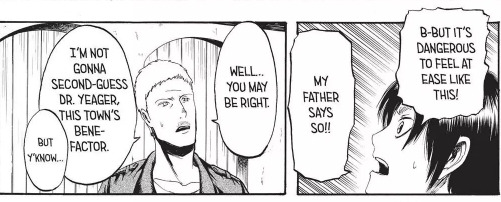
Carla, on the other hand, wished for Eren’s immediate safety and cared about him living a quiet life. But that also means she couldn’t understand his concerns, and the type 6 interprets that demeanor as vulnerability — his mother is more exposed to the threat. If the type 6 is a room where nobody is vigilant, the only option they see is to step up and become hypervigilant.
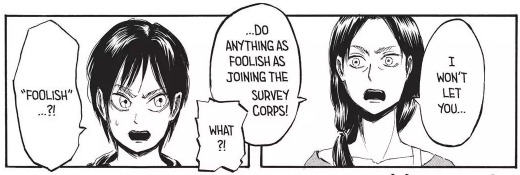
This relation to an authority is very specific for the type 6 as they search for people and systems in whom to rely on. Since the Garrison aren’t the most reliable soldiers around, Eren turns to the Survey Corps. That section of the military consists of the rebels, those who want to explore the unknown, understand the titans and figure out the best way to fight the enemy. The SC wants to be free, so they become Eren’s next “authority figure”.
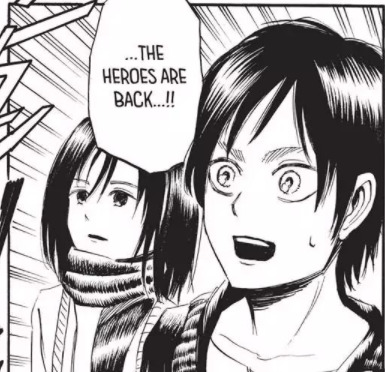
Riso also says that the type 6 in Level 6 has a more aggressive stance and wants to prove to others that he isn’t indecisive and can’t be pushed around.

“They blame and berate whatever threatens them. They become rebellious… and are desperate to latch onto a position or stance that will make them feel stronger and dispel their feelings of inferiority.”
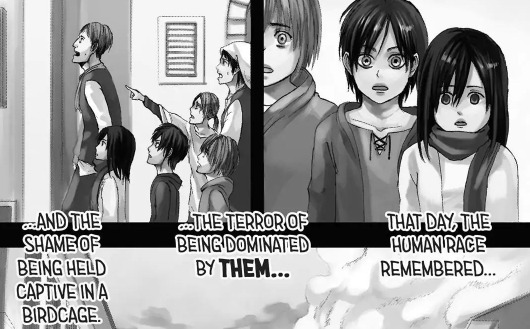
The type 6 feels inferior because they feel lost inside. Eren, too, knows that the threat lurking behind those walls is much bigger than him and a single human doesn’t stand a chance. And he berates people around him for not seeing what he sees, or for disrespecting his “heroes”.
Eren will be back to Level 6 later, embodying other aspects of it, but let’s talk about the moment he joins the army.
At this point, Eren reaches the stable position he has been eager for. He is part of a group and working towards his goals, he feels more confident because he’s preparing for the next attack. He has climbed to Level 4:
“The security which groups and institutions provide far exceeds the strength of any individual members...”
As we know, Eren sees his mission to eradicate all titans also as a social responsibility. The type 6 can easily fall into “us versus them” mentality where they are putting effort into something and will trust only the people who understand the importance of it. Eren’s bickering with Jean, as well as his admiration for Reiner starts from there.
“And even within their own group, average Sixes make it their business to find out who is pulling the weight and who is not... If others are not loyal or committed, it not only makes them angry, it threatens them.”
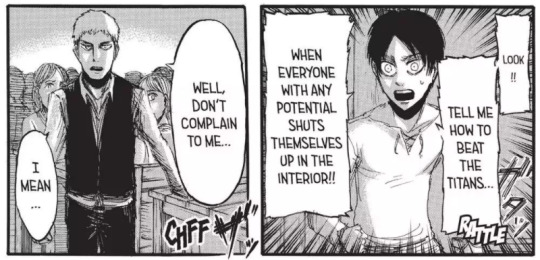
Eren talks over and over about how he’s going to join the suicide squad, to the point people start making fun of him. But he is testing everyone’s commitment to the cause of “fighting titans” and he finds people like Jean, who only really want their safe life, as well as Reiner, who is dedicated and understands him immediately. Reiner becomes his new “authority figure”: whenever Eren’s failing, Reiner is there to understand him, to offer help and to remind him of why he’s there.

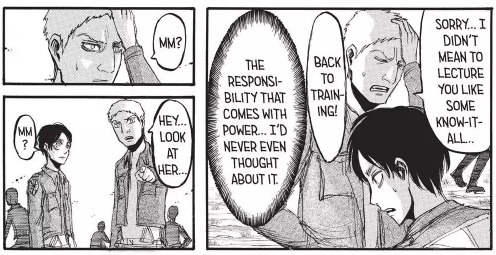
“The loyalty of average Sixes for the people with whom they have identified is almost without bounds. They find it extremely difficult to break their emotional bonds, even should they desire to do so… Their love may, in time, turn to hatred but never to indifference.”
That one speaks for itself. It’s exactly how Eren felt upon RBA’s betrayal. He’s in total denial about Annie, while for Reiner/Berthold all he has left is rage.

Choosing who to trust is part of the type 6 identity. All of their beliefs, all their inner world is shaken if they are betrayed, because the network they build is how they find a safe space for themselves in the world and how they orient themselves. Annie was Eren’s parameter of fighter, Reiner was Eren’s parameter of leadership. The first backstab is too hard for him to process, we see it all unfold. He can’t admit she’s a traitor, and he doesn’t even have the will to transform and fight her.


The second one, however, is embraced somewhat faster and he’s even able to contain himself and play along. But it doesn’t change how deeply it affected him and how vengeful he gets. Years later, that hatred would dissipate, but never to indifference — Eren still feels a need for some closure between them.

I got ahead of myself on the timeline, so I’m going to rewind to the moment Eren joins the Survey Corps, which is his childhood dream. Erwin is his main authority figure now and you see that, even though Erwin locked him up, he trusts the guy. As Don Riso explains, the type 6 on Level 4 plays by the rules of his group because he strongly believes in those rules and they bring comfort to their minds. In reality, the SC doesn’t really know what they’re doing. Erwin himself doesn’t know how he’s gonna cross the walls and find out the truth. But Eren is devoted to them. Their cause is his cause and he knows how hard it is but what matters is they’re trying. Besides, they embrace him. They want to reach the basement and want to defend him on the court and want to investigate/use his titan power. Thus, for Eren, the SC is the most solid and welcoming place to be. He’ll do whatever they want from him.
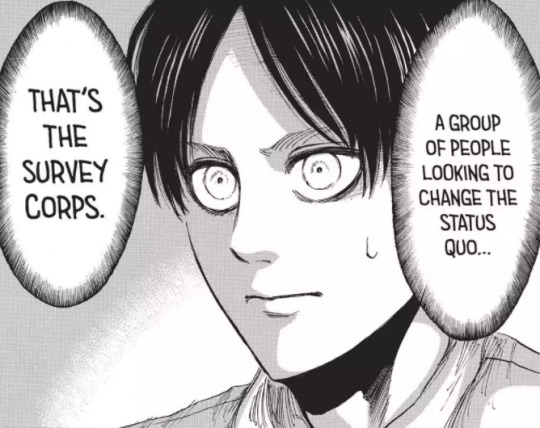
However, Eren was about to find out that things were far from glorious out there. Although the Survey Corps work under strict “plans” that soldiers are supposed to follow blindly, Eren can’t just watch people being sacrificed to protect him. Especially when he has enough power to act in a more significant way than those individual humans. But how much control does he have over his own power? Eren can’t answer that, and he feels immensely conflicted as soldiers continue to drop dead.
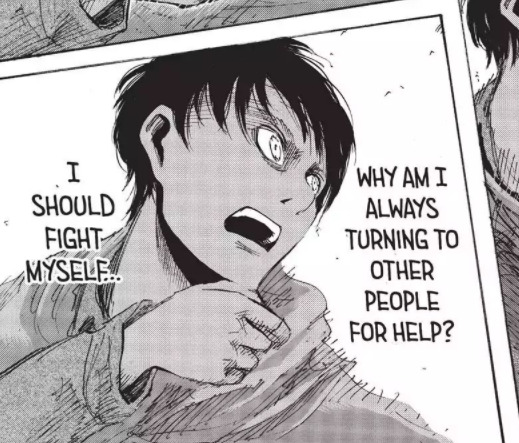
In that moment, Levi could’ve forced him to follow his orders, and perhaps that would’ve eased his mind when he chose not to transform. But the captain is a different kind of leader than Erwin, and he challenges Eren instead:

And I really appreciate how fitting that is to the type 6 conflit. It’s very difficult for them to accept it, sometimes there simply isn’t a clear path, sometimes it is okay to trust yourself and act on your own. But this is what Eren’s thinking:
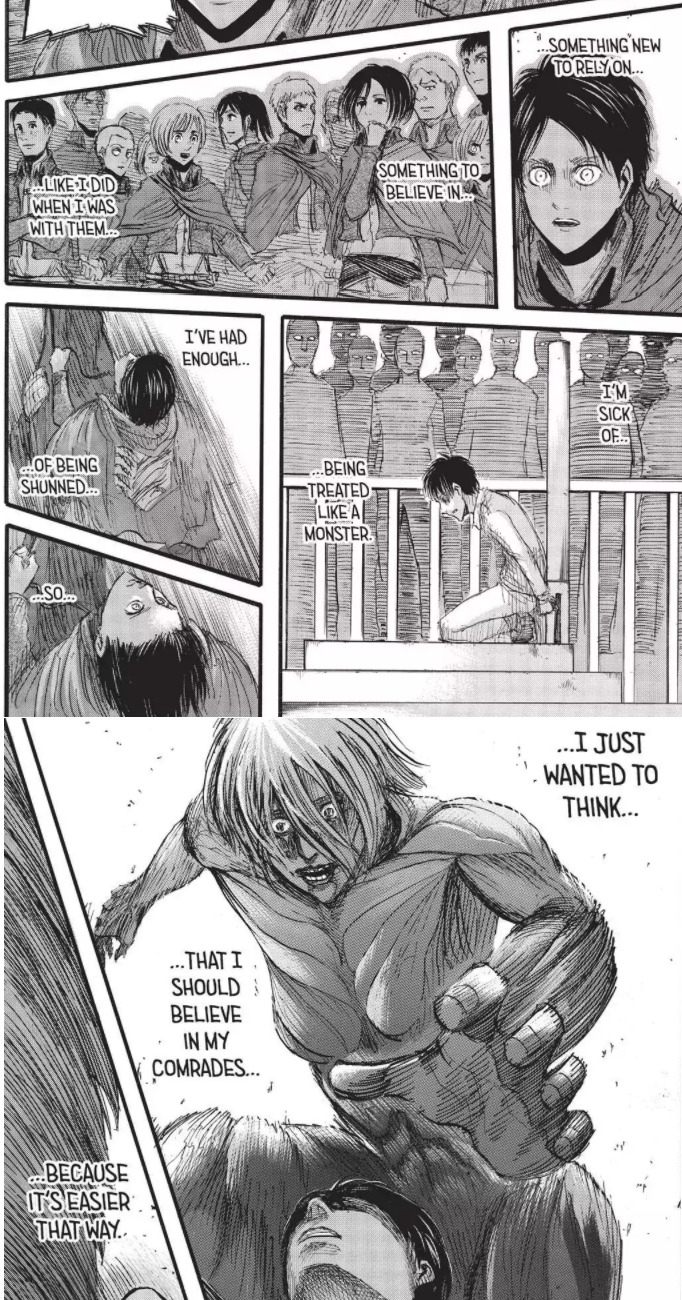
That didn’t turn out very well, did it? At the end of the expedition, Eren is forced to admit that the SC don’t have all the answers and that all his power and training can’t always keep everyone safe. He’s once again reminded of that after activating the Coordinate — not even the power to control titans can avoid sacrifices.
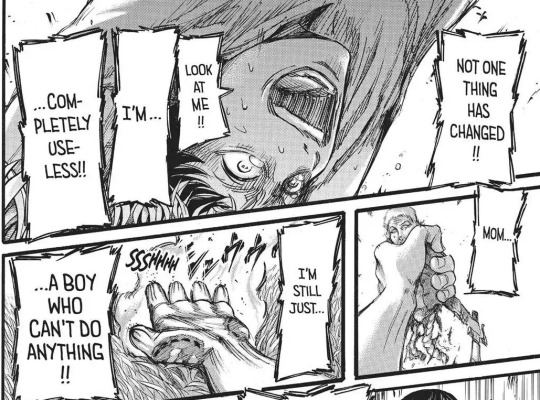
Ideally, the type 6 can only reach the safety they seek once they allow themselves to move in the chaos with the courage to face it step by step, instead of predicting it. This may sound easy for others but not for them, especially if they are inserted in a reality where the cost of a mistake is lives.
So we get to the Uprising arc. It starts with the Survey Corps planning the retake of Wall Maria while they put Eren through hardening experiments. Time is not on their side and Eren’s determined to go beyond his limits during the tests.
“They consequently try to further strengthen their ‘social security’ systems by working harder to be accepted and approved by their allies and authorities… Others wonder if they resent the workloads and pressures they seem to be under, yet Sixes seem eager to fulfill their obligations and duties...”

Eren’s entire world would fall apart again once he’s kidnapped by Rod Reiss and discovers the truth of his father’s sin. Like I said earlier, Grisha was one of Eren’s authority figures, and even though he was absent, the basement key and the promised truth kept son and father connected. Wherever Grisha was, Eren could still count on the answers he’d left behind.
That is, until he is hit by a trainwreck of a revelation that his father killed an entire family and sacrificed himself to pass on the titans to him. Eren’s left completely lost, he no longer knows what to think of himself, of the world, of his father.
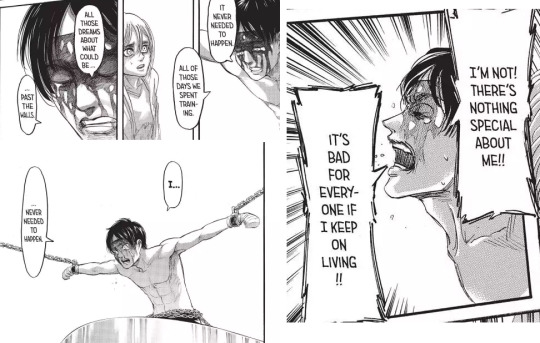
He falls from Level 4 to Level 7:
“Sixes become trapped in an unhealthy pattern of self-disparagement and massive insecurity which reinforces feelings of inferiority and worthlessness, a marked deterioration from the indecision and evasiveness we saw [before].”
This shift to a much more confused and self-loathing state doesn’t last long because Eren has his friend’s support for now. Historia chooses to see his worth and let him live. Levi once again challenges him to make his own decision, and Eren manages to save the day.

As Eren becomes aware of those destructive feelings, he tries to get rid of them by “fighting” himself, in an attempt to put himself back up.

He realizes he isn’t alone and he doesn’t have to do everything on his own, people around him are also strong enough to stand up for themselves. That helps him return to a more average stage and it could have been the beginning of his growth...

Well, if only life wouldn’t have a surprise waiting for him at every corner.
I hope you’re being able to follow and understand that we all have ups and downs in life. The levels of development represent exactly that, so it is common to find yourself in the same stage in different periods of your life. Nevertheless, after Eren learns the truth about the world and sees his future memories, it all goes downhill for him, no turning back anymore.

Here is what Riso comments on the ambivalence of the type 6 on Level 5:
“Sixes begin to follow the narrow path between the expectations of their allies and authorities and their need to resist having any further demands placed on them.”
Eren is overwhelmed by the view of the outside world. He has experienced his father’s memories first hand and it’s nothing like what he expected. No one around him has the same perspective. A lot of self-awareness and self-doubt emerge from the future memories he saw through Historia. Riso explains that on Level 5 the person starts to become more worried about how their allies feel about them.
“They become skeptical of new views and ideas, feeling that they have already put a lot of effort into understanding the perspectives and approaches they already know.”

Eren went from “I HATE TITANS ALL TITANS ARE MY ENEMIES DESTROY ‘EM ALL” to “titans are my people and they haven’t chosen this horrible outcome”. And that’s A LOT to process when you wrapped your life around that initial idea. But things are changing even faster, and his friends are talking about how the enemy could be reached out too. This thought needs to coexist in Eren with the clear image he has of the enemy, one that only he has accessed. Add to that how Eren was kept away from the Marleyan prisoners as Paradis also feared some kind of betrayal. As long as there’s people out there against them, he can’t so easily rest.
Who knows at what point Eren returns to Level 6. The time skip is covered very loosely. But probably when he is feeling so lost that he actually comes to Historia to vent.
“As in other types, to be functioning in this Level or lower usually indicates that there were extremely dysfunctional elements in the child’s environment.”
Self-explanatory. It’s even hard to talk about Level 6 because it is a point where Sixes start to overthink threats that aren’t that big, but in Eren’s case, the threat is 100% REAL and there’s a world isolating them and wishing for his people to die and throwing gigantic creatures at them. No big deal at all.

Eren turns to the people who actually understand the urgency he feels. Floch is eager to follow him, while Zeke and Yelena have an actual plan. Eren says he’s acting out of his own decisions, and he sure is, but he has also left it in Zeke’s hands to set the course. At this point, it no longer is a positive thing for the type 6 to have reassurance instead of a grounding support, it’ll only leave them trapped in the current mentality.
What would be more appropriate would be a balance between rejection…

…and full acceptance.

(By the way, I can’t even know where Historia stands, since she let him do his thing, but I’m still using her here because of how immediate her reaction was, which could lead Eren to think he can’t risk telling anyone else. Unhealthy Sixes are just that paranoid.)
Zeke could have been Eren’s new “authority figure“ if their goals were the same. But more and more the only thing Eren is starting to rely on are the future memories.
Riso talks about how a violent environment would lead to violent actions and “they end up using the same aggressive tactics on others”. And I can draw a parallel with how Eren has been facing titans for so long and watched them take people from him, that he just feels aggression arise whenever he thinks of all the injustice he has witnessed. Same would happen later on, when he sees Ymir’s memories and finally decides to unleash this pain on the world.

“It’s hard for Sixes to work for something. Instead, their energies are galvanized by being against people and things.”
Despite being highly conflicted and problematic, Eren so far has waited. It’s too hard at this point to fully engage with those dreams, but he has watched things unfold and allowed the Survey Corps to do their stuff and try to contact the outside world. On Level 7, the type 6 is just going through the day with little hope. When the SC reaches Marley and Eren meets the boy of his memories, he can no longer escape from facing himself.
“Tearful and obsequious, they are disgusted with themselves for not having been tough enough to stand on their own two feet, to defend themselves, to be independent.”
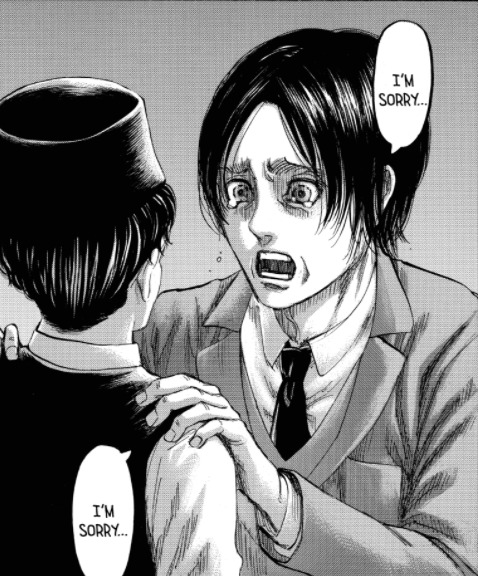
Not only Eren, but Paradis as a whole, have been unable to be independent in a much bigger world, or this is how he sees it after Kyiomi monopolizes the resources and the pro-Eldians group rejects the island. Finally, Eren recognizes in himself the person who would be capable of trampling the kid he currently wants to save, and that leaves him disgusted.
“They do not necessarily deceive others maliciously, but to escape punishment or abandonment. They believe they may be able to repair the damage they have caused...”
What Riso is saying here is that the type 6 feel the need to hide (themselves) so their loved ones won’t abandon them. And again, in Eren’s case, he has a damn good reason to think his loved ones might not be super happy if he said he was going to destroy the whole world. Let’s not forget they are the people who counted on him to save the world this whole time, and he is the person several people have been sacrificed for.
All this pressure has brought him this low, but Eren reaches rock bottom when he allows himself to admit he wished for it all to be destroyed. Now, he can no longer face his family (as he would tell Falco) and he has little faith in himself.
Again, Eren’s paranoias aren’t so far from reality because there is, indeed, a world against them, and that keeps feeding into his anxiety. Paradis’s progress is little and the future is uncertain. When the type 6 reaches Level 9, they can no longer get out of this spiral. They know it’s only a matter of time until the threat comes to them. So they call the threat upon themselves.


Eren allowed himself to go as far as understanding his enemies and accepting that they’re the same, but with the declaration of war, he can’t wait anymore.
I already told you the reason: the type 6 needs to be able to predict. That’s the very core of their beings, their minds seek to control events. Striking first is their final attempt to make sure they won’t be taken by surprise. Ultimately, they are lost and desperate to find support again. Here’s what Riso says about the type 6 on Level 9:
“They may drop out, abasing themselves as vagrants and living in skid row conditions, thus allowing their health and minds to deteriorate to the point of no return.”

It almost feels like Isayama has read this book, I swear to God. Yeah, that’s word by word what Eren does. He goes to enemy territory, injures himself and throws himself in war. Despite resisting for so long to a new perspective of his enemies, Eren allows himself to see them with his own eyes. All because he’s desperate to understand his enemy, desperate to understand himself (and what would lead to his decision) and desperate to run away from his friends. He is ashamed of choosing those future memories as his new authority figure, get it? They are the most certain thing in his life now. As much as he waited and as much as the SC tried, they don’t have any guaranteed future and it’s just too hard for the type 6, especially unhealthy Sixes, to wait. It’s impossible.
Remember I said that Sixes want to feel understood? Well, I think Eren feels understood, to some degree, when he’s among those broken soldiers. They are relatable, more than anyone else.
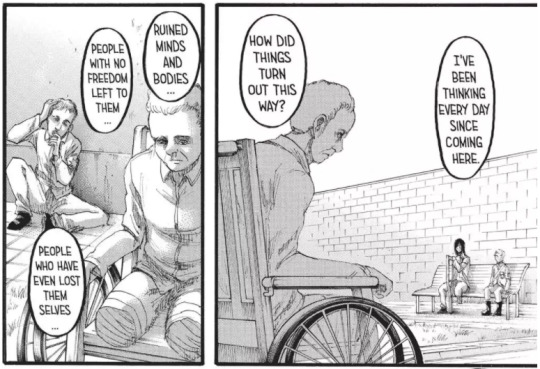
“Neurotic Sixes bring disaster of some sort upon themselves not to end their relationship with authority figures, but to reestablish a protective one. [...] It is also important to notice that neurotic Sixes are masochist not because they take pleasure in suffering as such, but because they hope their suffering will bring someone to their side who’ll save them… as if to say, ‘Punish me, because I’ve been bad. Then you can love me again.’”
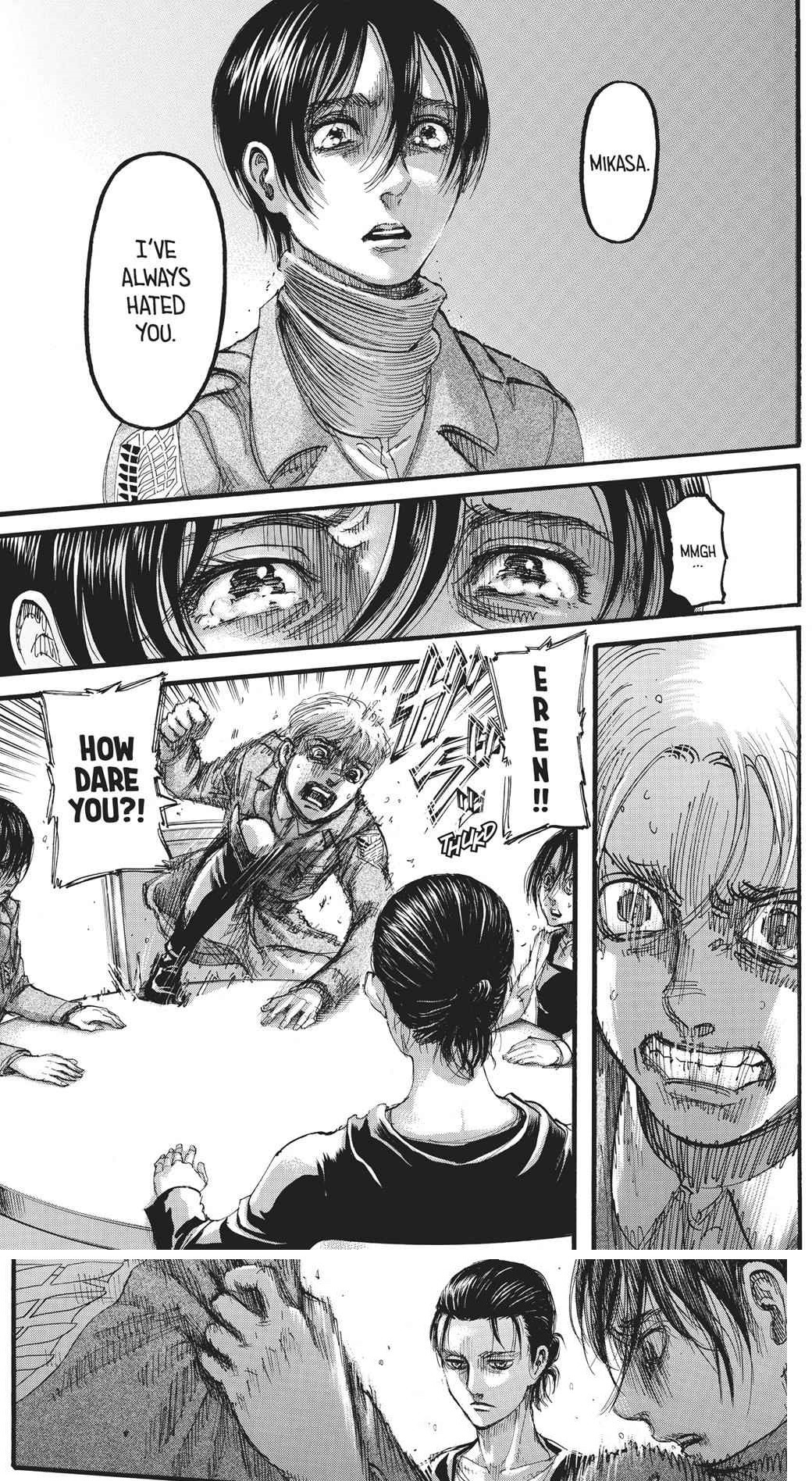
In the mind of the unhealthy type 6, if he can’t find the answers, he can’t be there for his allies. If he fails his allies, he doesn’t deserve their support. But even when he feels he doesn’t deserve it and feels they won’t forgive him, he desperately needs it — the type 6 doesn’t know how to live without support. He is completely aware of his cowardice, he may unleash his despair in innocent people, he seeks punishment for his behavior and hopes for someone to end his pain.
“Unhealthy Sixes are self-defeating persons who are their worst enemies. If they persist in their masochist behavior, neurotic Sixes will drive away everyone on whom they depend. They will be abandoned and alone, the very things they most fear.”
Eren pushed everyone away, but deep down he waited for them to come to his rescue. He knew he was a lost cause, but still couldn’t let go of what he saw as a compromise, a duty to them. His completely cruel and extreme actions are, in enneagram terms, his way to not leave his allies adrift. But aren’t all his actions for his own freedom? I don’t think so, not entirely. There’s a reason the type 6 has been named “the loyalist” — they always, always see themselves as part of a group. And in the end, he saw himself in Ymir, someone who was trapped and waiting to be rescued, understood. Don Riso says the worst part of coming this low is how much Sixes hurt others while they hurt themselves, both because they want to harm everyone who doesn’t understand and to show people the worst in themselves; they want to punish and be punished at same the time.

That is what I wanted to break down — Eren’s inner process. Yes, the type 6 is an ambivalent, contradicting personality type, precisely because that’s how they feel inside. Other enneagram types don’t escape from their own personal conflicts, that’s also important to point out. The enneagram does not define integrity, people capable of causing great harm exist in all types and no one from type 6 is fated to destroying the world — just in case that isn’t obvious.
This post is heavy, I know. One of the things I love about SNK are the emotions it evokes and how human characters are. I’m so thankful to have followed Eren’s fascinating journey. He has never hit me as a one-dimensional character as some people claim. To me, Eren is not a chad, he’s not a monster, either. He’s just human.
I’m thankful for this fandom as well. We’re a total mess but the monthly wait would’ve killed me without the crazy theories and the heated discussions.
#snk 137#snk 138#snk 139#Eren Jaeger analysis#attack on titan manga and anime#enneagram#LONG post#eren jaeger#snk analysis
59 notes
·
View notes
Text
Dream – 6w5
Dream is strangely difficult to write an introduction for. On one hand he seems like an aggressively normal nerd, on the other hand he’s got a set of qualities that people either connect with intuitively or completely do not grasp. Dream comes at us from the notoriously paradoxical type Six, known for their careful and obsessive planning… as well as their impulsivity. Still, Dream is deceptively simple once you know what to look for.
Like Clockwork
Much like Tommy, Dream sees YouTube like a video game. He’s pursued it intensely for years and strategized his rise to the top, paying careful attention to what kinds of techniques work and why. He’s a natural information gatherer and tries to be a couple steps ahead of what he’ll need when the time comes, looking for ways to create and sustain his success. Overall, YouTube has served as a structure to stabilise himself, giving him purpose and direction.
As his primary game, Dream has fused Minecraft into his DNA. The way he got to be a speed runner to begin with was the combination of the type Six affinity for systems and their ability to marry that system-based thinking with instinct. Manhunts show what happens when his systems brain meets his reflexes under pressure, making for an interesting watch.
The Loyal Sceptic, part ii.
Dream kind of needs to be structured from the inside out to orient himself. Because this is so personal to him, he has a strong stake in being sure that him and other people are going off sound, sturdy information. Dream can be quick to spot holes in plans and logic, fixating on them and trying to find ways to work the problem based on what he already knows.
Dream is concerned with ideas and figuring out ‘right’ from ‘wrong,’ sometimes from engaging directly with other people. He doesn’t do this smoothly, but he certainly does it a lot, getting into big and small arguments about things to come to shared conclusions about the truth. The thing is, Dream ‘debates’ people that he doesn’t like as well as those that he likes, to be sure that people are following sound logic and making ‘the right decisions.’ He’s not combative just for the sake of being unfriendly, but boy it can come off that way if people don’t know how to interpret him or he's getting carried away.
MCC serves as an example of times when Dream takes on a troubleshooting strategist role with other people. He’s good at analyzing both the players and the games themselves, seeing things down to the detail and optimising plans for better results. In general he likes using his skills to help people reach their potential and lean into their strengths when he can.
The Five Wing
Dream’s Five wing makes him slightly less expansive than a seven wing, preferring to keep to his established sphere of friends. He likes spending low-key time with people, but also has a tolerance of thinking and working alone for long periods.
Dream has been isolated for years now, largely out of stubbornness around his face reveal, and some of his ability to handle that is his more withdrawing nature. The online setup is probably a good middle ground for him, stimulated by the ongoing company of people but without direct person-to-person contact. While it’s likely that Dream will enjoy face to face interaction, it may tire him out a bit faster than it would a seven wing.
Oddly Casual
Something worth noting is that Dream still seems to think of himself as ‘just a guy.’ He doesn’t separate who he interacts with by rank or status, meaning that he’ll engage with anyone if posts are available on a public forum. He replies to people, posts on reddit, jokes with fans and gets into scuffles with fans and enemies alike.
This might be his version of Tommy’s “awkwardly social” quirk, having fleeting engagements with other people to feel stimulated and connected, but with added room for confrontation. He can be abrasive, but that abrasiveness comes from being oddly genuine, preferring direct conversations without too much polite pretense. People talk a lot about parasocial audiences, but truth be told Dream is parasocial right back, preferring to start conversations as though the ice has already been broken and it’s okay for him to 'play-fight' with the people around him.
Counterphobia
Like most Sixes, Dream also has a counterphobic streak. Dream pushes towards danger when he feels like something is threatening, and this comes out as reactive aggression when he feels like he or one of his friends is being targeted. Yes, this is where a good chunk of his social media fights come from.
This is a fire meets gas situation where his built-in anxiety makes him sensitive, and his instincts make him reactive. It makes sense that he tested as an Eight—he can be very combative when he’s in this state, wanting to try and fight things out hands-on. It’s taking him time to be less immediately aggressive when he feels attacked, learning to step away from things that set him off and calm down before he says something regrettable. He is capable of cooling down once the reaction window passes, but it’s a deeply wired reflex so it’s hard to get rid of entirely.
Shoot First, Ask Questions Later
Dream is protective of his friends. Like, very protective. This is both from his loyalty and his ability to see the potential for danger in situations. This means that he’s willing to go into situations guns blazing to protect the people he cares about… even when they’re in the wrong. If a friend of Dream genuinely fucks up in public, he’s likely to try and defend them publicly, and then grill them brutally behind closed doors to make sure it doesn’t happen again. Dream also has a habit of throwing himself under the bus when his friends have done something, preferring to take the heat himself.
Dream is slower to loosen his grip and not see things from a ‘his people’ vs. ‘attackers’ perspective. The exceptions to this situation tend to be when either two people or two groups that he’s equally invested in start fighting, in which he gets more conflicted but equally compelled to intervene.
O Captain, My Captain
Dream slots himself into the leader role for a number of reasons. For one, it puts him in the driver’s seat and lets him strategize in situations. On top of that, it gives him a unique place in peoples lives, which helps him feel secure in his relationships. Being a leader-type both gives him the connections and the freedom that he finds most comfortable.
Like most Sixes, Dream also comes from a place of anxiety around abandonment, and inversely a desire for connection. His inner circle is defined by people who he expects to be with for a long time, looking to both give and receive loyalty. In return he takes care of the people around him, both as a social support and materially.
Dream has a deeply held sense of “his people” who he wants to extend his skills towards and protect from harm, and this includes his audience. Dream’s ongoing choices to change for and defend his fanbase are a significant part of his rapport with his community, and is a nonzero factor in his success. His default reflexes to defend his audience may not be popular, but he was one of the few popular male gaming CC’s who were willing to see a young majority female audience and defend them warts and all, which most male CC’s up until that point would be more reluctant to do. Like his friends, Dream wants to see the best in his following, for better or for worse.
#drm 6w5#he protec and attac and attac and protec and protec by attacing and it don't stop coming#There were a lot of little moments writing this where i was like 'Tommy does this too' but he's less known for it#6 tag#counterphobia
17 notes
·
View notes
Text
Hello!
I am the ENFP who asked you about the enneagram recently. I am investigating the possibility that I may be a 9. I read that its core fear is conflict, but I sometime read about the fear of loss and separation. Which one would be the real one? I relate very much to the fear of separation and loss (of relationship mainly) but I don't see how it could be a manifestation of the famous "sloth" (as you have to go toward people to maintain relationships). How is it different from the fear of being unloved or unwanted?
The "sloth" referenced as regards 9 is not about laziness, but slowness to spiritually develop oneself as separate from others; slow to leave one's comfort zone, enact change in their life, and attack life with the ferocity of the other types. It's a spiritual and psychological sloth born of contentment with living within your comfort zone. What does this mean in layman's terms? "Getting a better career requires too much work, that would make me uncomfortable and anxious, so I'll just stay in this one." "Pursuing that person romantically might introduce me to uncomfortable feelings of rejection or shame... I don't want to face those, so I'm fine the way I am." "I'll get around to it." "This person hurts my feelings a lot, but breaking up with them would upset them, and that would upset me, so I won't. I'll just stick it out."
9s hate change and don't like having things ripped away from them, because it introduces a bunch of emotions and feelings they would rather not feel -- it introduces an "upset" into their "calm." Their desire is to maintain an inner state of calmness at all times, which means tuning out whatever they do not like or that makes them feel anxious, so they can calmly go about their day doing what they like. But this disconnect also means being easily distracted, because they aren't really tuning in to reality; they're creating a cloud around themselves and living in it, where nothing can quite penetrate them.
I also read about enneagram countertypes (who would have different behaviours compared to the usual manifestation of the enneatype). For example social 9 could mistype as 3 or 7? What do you think about this theory.
I think countertypes are nonsense, other than cp6, and even there, all 6s have degrees of phobia and counterphobia. Countertypes are often used as an excuse to mistype, along with tritype ("I am this, but 90% of it doesn't quite fit me, but that's okay, because I'm a social/sexual/8-fixer/4-fixer/5-fixer...").
As much as I relate to the 9 core fear (I relate also to the 2, 3, 7 and 8 core fears) <- relating to everything pretty much proves 9, since the 9 has attributes of all the types and merges into all the types.
), and even if I daydream a lot when confronted to tedious tasks (drifting away is easier than being present to that kind of things) <- 9 trait.
, I always have been very proactive in my life and prone to overlook rest. <- what can you use as an explanation for this? That you are sp/so? That you are a 9w8? That you are an J type? Look at everything like a puzzle and see how it all fits together.
Moreover, even if I perceive myself as soft and agreeable, people seem to always have seen some kind of aggression and intensity in me. A friend who never saw me angry once told me that in a hunter gatherer society I would definitively be a hunter. I have trouble conciliating how I think, how I act and how I am perceived, hence my questions.
I know an sp/so ISFJ 9w1 who is passive a lot of the time, but you make her mad and you'd better watch out. She is fierce when you rile her up and would be extremely proactive in protecting her loved ones and ensuring she has enough resources for them. So, your MBTI type, your stacking, and your core do matter.
Thank you very much, and congratulations on your book!
Thanks. :)
18 notes
·
View notes
Text
I was very single-track minded in my appointment today.
But intrusive thoughts got brought up by me thanks to the episode.
And I’ve basically ID’d a few flavors of it in myself:
Negative self-talk / core beliefs - “nothing I do is enough“. I’m better at challenging it nowadays than in the past. Sometimes you gotta remind yourself that you’re doing your best.
Trauma flashbulbs/flashbacks. Self-explanatory. Unpleasant but not unexpected experiences. Completely understandable after That Shit. Another reason for self-compassion.
“Forbidden Candy” thoughts while handling my dad’s meds. No, those are not Mike & Ikes nor Smarties... Do Not Eat. You don’t even like those candies much, anyways. No less amusing to myself here.
Intrusive horrific/gory imagery (not often... but often used it for artistic inspo after initial shock/disturbance subsides.)
This all to say, more reasons why I like Remus as much as I do.
Like. One of my own draws to horror is counterphobia - deliberately going toward the stuff that gives you fear and anxiety and coming to terms with ‘em (in a safer and more manageable way).
(Hell, I’m prone to hypochondriac thinking and I love body horror.)
#sanders sides#remus sanders#(i am yet again really wanting to put this in the IT tag because i'm using fandom as a means of expressing/analyzing them)#(just another part of how my brain just operates man)#(that self-talk bit? yeah. that's one reason i love roman angst)#('cause i'm all too familar w/ tearing myself down)
5 notes
·
View notes
Text
The “Counterphobic 6″ vs. 8 Conundrum
So this was the thing I wrote after a typing session that finally cleared my accurate Enneagram type. Basically this details the key distinctions between Type 8 and a more “counterphobic” variety of Type 6.
Let’s get all the introductions out of the way: I’m an SP/SO 6w5 with 683 fixes, which puts me in the same caliber as dickheads, douchebags, and dictators.
I also happened to mistype as an 8 (which wing depends on the time of day) for a while until I swapped that card over for a new, shiny 6w5 card.
With this humble piece, I hope to share my story of mistyping, clarity, and in the end, shed some light on the differences between 6 and 8 from the point of view of someone who has fallen into that very same mistyping trap.
MY MISTYPING HELL
I got into the Enneagram through a friend and after a few attempts of testing and conversations with a couple of friends to gauge some observations, I typed myself as an 8, and off I went (I swung between both wings but I didn’t understand why at this point).
As I went deeper into studying the Enneagram, I came across the concept of “phobic” and “counterphobic” when it comes to Type 6. At some point in my deep dive, a lot of the “counterphobic” descriptions hit a nerve a little too close for comfort, and started having doubts about my core type.
That’s where I hit Google and attempted to seek answers to my little conundrum. Unfortunately, instead of finding answers, I found mostly the following:
Half-baked descriptions of both 6 and 8 that never got to the core of either type
Circlejerk threads of 6s (mostly men) posturing themselves as Eights and digging their heels when questioned about the possibility of mistyping
The branding of 6 (especially those who lean towards counterphobia) as “Wannabe 8s”, which has some anecdotal origins, but it loses the essence Sixes have that’s unique to the type.
And many others…
Yet despite all that, I held on to my 8 typing for dear life, while still open to the possibility of mistyping. It’s a walking contradiction of sorts, but such is the life of a Six.
FINDING CLARITY
During my time studying the Enneagram, I came across this site called Enneagrammer, and along with it the Big Hormone Enneagram podcasts. As I pursued all this information, I’ve gained even more clarity about the various types and their relationships with each other in a way I’ve never understood it before.
Despite all that, the question remained: Am I a 6 or an 8?
In a last-ditch attempt to find answers, I caved in and purchased a typing video reading. Unfortunately, I submitted mine during a time where a lot of people did and ended up swapping it with an hour-long typing session with Emeka, one of the ad.
I’m glad I did.
Fast-forward to the 30th of October 2020. I had a difficult time sleeping the night before due to a mix of excitement and anxiety. Thankfully it was first thing in the morning so once I got up and freshened myself up, we started the typing session.
Not even 15 minutes in, the distinction was clear as day.
Emeka explaining how 6 operates, and how my wing, fixes, and stacking interacted to form the full picture of my type felt like someone read my deepest, darkest secrets. It’s like when you’re on stage and your pants fell off in front of an entire audience, but at the same time, it’s in a way validating in an “I feel seen” type of way.
My full type from my 5 wing, assertive fixes, and self-preservation stacking makes for a more “grounded”, earthy flavor of the 6 (as opposed to many type 6 descriptions which appear to have 6w7 in mind). Unless people know what to look for, I can look like a gut type at first glance.
Despite what appearances and first impressions show, the “counterphobic” 6 (who are probably likely to be 8-fixed 6s) have some significant key differences that distinguish them from true 8s.
AGGRESSION AND REACTIVITY
Both 6 (especially 8-fixed 6) and 8 can be aggressive and territorial. As both types reside on the Reactive triad, they’re both intense types who aren’t afraid to let other people know about how they feel about something.
The key difference between both is the motivation behind the aggression.
For starters, the 8 brand of aggression focuses on creating their reality through action and expansion. This makes for a calmer, more deliberate, more shameless type of expressing themselves due to the lack of superego influence.
6’s aggression, on the other hand, happens as a response to the swinging pendulum in their head (or “splitting”) and is usually a cover for deep-seated anxiety. The thing with 6 most of the time is that we don’t even know that we’re anxious – the underlying anxiety is the baseline.
As a 5-wing, my way to seek certainty is to hoard information and devise structures to give me that map. Sometimes it gets to a point where I haven't taken certain factors into consideration (especially because...people are people, and can be unpredictable). When surprises happen, my first instinct is to push on as a reaction to those surprises (because reactive type), which is where the aggression comes from.
It takes a lot of self-reflection and insight to get out of this trap, but with some work and self-reflection, it can be done.
HEAD VS. GUT
All Head types attempt to find a way to orient themselves, frame reality as they know it, and concoct a narrative that makes sense to them, as distorted as the result would be. For the 6, this comes in the form of “what ifs” and worst-case-scenarios.
The 6 is most especially in tune with the nuts and bolts of the systems that matter to them the most. They would be the first people to spot if something is off, which makes them excellent troubleshooters, problem solvers, and project managers.
6’s signature ambivalence leads them to find rational ways to prove a point. For one that’s mistyping as an 8, this can look like trying to create scenarios and reasons to convince others that they’re an 8, which is even more proof of the mistyping at hand.
8s, on the other hand, are the system. They would just chuck everything out, push their way into things, and rewrite reality as it suits them regardless of health level.
INSTINCTUAL STACKING MYTHS
There’s also a pervasive myth in online typology circles that “counterphobic” 6 can only be sexual types. As a self-preservation 6, I can tell you off the bat that this couldn’t be way more off-base and is one of the primary reasons I mistyped as an 8 for so long.
“Counterphobic” 6s can be of any instinctual stacking. The notion that they can only be sexual types can only operate under the assumption that 6 can only be phobic or counterphobic, which is counter to the signature duality of the type.
6 phobia and counterphobia lie on a spectrum. How an individual 6 reacts depends on the person and situation. What the stacking tells you is what instinct this duality is most especially apparent.
For me as a self-preservation 6, this happens when self-preservation issues of health, finances, and lifestyle are at stake. This especially makes me extremely controlling and territorial of my space and any “intrusion” will send the alarm bells.
The main distinction with the 8-fixed 6 brand of boundary defense compared to that of the 8 (which is a more offensive-centric type) is that we tend to be much more vigilant of the boundary and pre-emptively strike before you even cross the line.
ATTACHMENT VS. REJECTION
The final key difference between 6 and 8 lies in one being an attachment type (6) and the other a rejection type (8).
6 (even with assertive and rejection fixes), for all their bluffing and blustering, are at the core attachment types. Whether we’re aware of it or not, as attachment types we have the need to be connected to “The Grid” (whether it’s people, systems, or anything that connects us to the world at large).
This gives us 6s a “testy” quality. We test and probe the people we interact with and change course depending on their reaction. Kind of like how our image-focused 3 siblings do except the reason why we do this is to help us orient the compass rather than craft the best image for the job (that is get the most value).
Meanwhile, 8s, their forceful action is a form of separation and dissociation from “The Grid". As rejection types, they assume right off the bat that they’re going to be rejected and thus offer their strength and willpower as they reject their vulnerability.
THE POWER OF WINGS AND FIXES
Like all attachment types, a 6 core is a “blank canvas” that gains its color and shape based on the wing, fixes, and instinctual stacking.If the core type, wing, and stacking are the main colors, the gut fix are the shadows, and the heart fix are the highlights.
6w5, specifically (due to the influence of the withdrawn, competency-focused 5) tend to be more private, cynical, and “grounded” than the 6w7 and can look like an 8 at first glance. This could all be just me projecting my experiences on to you, but that’s for you to decide.
A 6w7, on the other hand, tends to have more scattered energy due to the 7 mix. This makes for a more optimistic, emotional brand of the type that tends to mistype as 2, 4, or 9.
The narratives of “fighting for the underdog” and “toughening themselves up” usually attributed to 8s are more appropriate to the type 6 (I mean, 6w5 specifically is named The Defender, for God’s sake). More so because we have the hardest time accessing our courage.
Because how do we do the thing when we don’t know what the thing looks like?
What gut fix the 6 has adds striking color to the type: 9-fixed and 1-fixed 6s deal with underlying anxiety by mostly withdrawing from the source (9-fix) or contorting themselves to a standard in the attempt to quell the fear (1-fix).
8-fixed 6s? We just huff, puff, and take action to get it over with.
An 8 fix gives the 6 the license to “be” a 6 and wear the "ping-pong" game on their sleeve. The 6 “Inner Committee” (as Riso brands it) has a meeting every single time we make a decision, and for those of up with 8 fixes, it’s like telling them to shut the fuck up and stomping out in a huff to do the damn thing.
Because of this, an 8-fixed 6 will look more like the 8 stereotypes than an actual 8. 8-cores tend to be much better at picking their battles and knowing when to drop it when something is not worth it to them.’
The heart fix adds yet another dimension to the 6. Adding a 4 heart fix will make the 6-8 even more reactive and “raw”, whereas a 3 heart fix gives the 6-8 stem more tact and an emphasis on “reacting to get a certain reaction”. A 2 heart fix makes for a more people-focused, overbearing parent-figure type of quality.
The 6 can be many things, but “mediocre” and “same-y” is definitely not one of them.
WHY THE CONFUSION AND WHY ADDRESS IT?
Now that we have the differences out of the way, it’s good to ask, “If the differences are clear, why are people confusing the two types anyway?”
The distinction between 6s and 8s has been a subject of online debate since time immemorial. Based on my observations and experience, this is due to several things:
Confusing descriptions that end up adding more questions than answers. We’ve seen this happen with type 4 vs. 9 (another common mistyping), and unfortunately, some discussions blur the distinction for 6 vs. 8 even further.
A society that reveres certain types of strength more than others. This is how many (mostly male, based on observation) 6s posture themselves to the idealized, “powerful” version of the 8 without taking into consideration the dark side of the type.
The bad rep attachment types in general get. For all the pitfalls of 6, they also have their own strengths other types can learn from like loyalty, insight, and anti-elitism.
Defining the distinction between types helps people genuinely see themselves for what they are, warts and all, and helps lay the foundation for fruitful, meaningful inner work that gets us out the trappings of type and connect in a truly authentic way, no matter what type you are.
It gives the space to respond instead of reaching for the first instinct without a care for how it affects the big picture, and for the 6, it serves as the orienting needed to set the course and open up to other possibilities.
18 notes
·
View notes